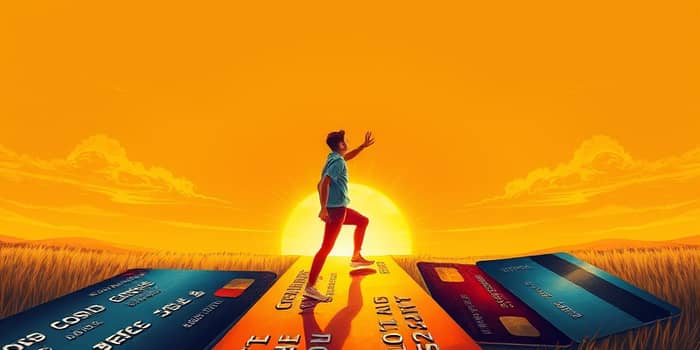
Taking control of your finances starts with understanding how credit cards can be both powerful tools and potential pitfalls. With the right approach, your first credit card can pave the way for responsible money management and long-term stability.
A credit card is more than a simple plastic card; it is a financial instrument that allows you to borrow funds up to a set credit limit for purchases and cash advances. Banks or credit unions issue these cards, and payment networks like Visa, Mastercard, or American Express handle the transactions behind the scenes.
Each credit card account follows a monthly billing cycle. You receive a statement outlining your charges, and you must make at least the minimum payment by the due date. If you pay in full during the grace period, you avoid interest charges entirely. Otherwise, outstanding balances accrue interest at the card’s Annual Percentage Rate (APR), which averages 23.37% as of August 2024.
Credit limits are determined by the issuer based on factors like your income, existing debt, and credit history. Unlike a debit card, which withdraws from your own bank balance in real time, a credit card lets you spend now and pay later. Responsible usage helps you build a strong credit history, unlocking better financial opportunities over time.
Credit cards offer benefits that extend beyond basic purchasing power. For beginners, they can serve as stepping stones toward greater financial freedom. Consider the following advantages:
Choosing the right card depends on your financial profile and goals. By understanding common card categories, you can narrow down your options:
Selecting your inaugural credit card involves evaluating key factors that impact your long-term finances. First, compare interest rates (APRs). A lower APR reduces the cost of carrying a balance. As of mid-2024, the average APR stands at 23.37%, but introductory offers can be as low as 0% for six to twelve months.
Next, consider annual fees. Some cards charge no fee, while others offset benefits through a modest yearly charge. Always calculate whether the rewards and perks justify any cost. If you plan extensive travel, travel rewards cards may waive foreign transaction fees and provide travel protections.
Assess the credit requirements. Secured or student cards accept users with limited or no credit history, while premium cards demand higher scores and incomes. Also, review additional fees such as late payment penalties, balance transfer costs, and cash advance charges. Finally, look for sign-up bonuses, which can deliver substantial value when you meet a minimum spending threshold within the initial months.
Understanding credit terminology is crucial for making informed decisions. Familiarize yourself with these concepts:
Credit Limit: The maximum amount you can borrow on a card. Balance: The total amount you owe on your card each billing cycle. Minimum Payment: The smallest required payment to keep your account in good standing. Grace Period: The interest-free window between the statement date and payment due date. Credit Score: A three-digit number reflecting your credit risk, influenced by payment history, utilization, and length of credit history.
Starting with one card and following disciplined habits will set you up for success. Embrace these guidelines to cultivate healthy credit behavior:
While credit cards bring many benefits, they also carry risks that can derail your financial goals if unmanaged. The average APR of 23.37% means that carrying a $1,000 balance will cost you roughly $234 in interest annually. Over time, paying only the minimum extends your debt repayment by years and dramatically increases your overall cost.
Fees can accumulate quickly. Late payments incur penalties and can raise your APR. Cash advances typically carry higher interest rates and additional fees. Behavioral studies indicate that 35% of cardholders believe they spend more when using credit, and 37% would reduce spending if rewards ended. Maintaining awareness of your habits is key to avoiding a debt spiral.
Rewards cards can add up to significant savings, especially if you channel everyday expenses like groceries, gas, and utilities onto your card. With 71% of Americans using rewards programs and 80% valuing them highly, these incentives are hard to ignore. However, if you carry a balance, even generous cashback earnings can’t offset steep interest charges.
To maximize rewards safely, treat your credit card balance like cash. Plan recurring expenses you would incur anyway and then pay off the statement balance in full. Track reward categories and special promotional offers such as elevated earning rates on dining or travel. By aligning your spending with your lifestyle, you gain maximum impact without falling into debt.
Begin by obtaining your free credit report from Equifax, Experian, and TransUnion to understand your starting point. If you have no credit history, secure a secured card by depositing the amount you wish to borrow. Next, set up autopay for at least the minimum payment to ensure timely payments.
Create a simple budget that treats credit card charges like cash transactions. Review your monthly statement and categorize spending to identify areas for adjustment. Finally, gradually diversify your credit profile by maintaining a healthy mix of credit types while keeping new applications to a minimum. These steps will help you progress from a beginner to a seasoned credit user.
Credit cards, when used wisely, transform from simple payment instruments into gateways for financial empowerment. By understanding how they work, selecting the card that aligns with your goals, and following best practices, you can harness their benefits while minimizing risks. Your first credit card is not just a financial product—it is your first step toward lasting financial independence and opportunity.
References













